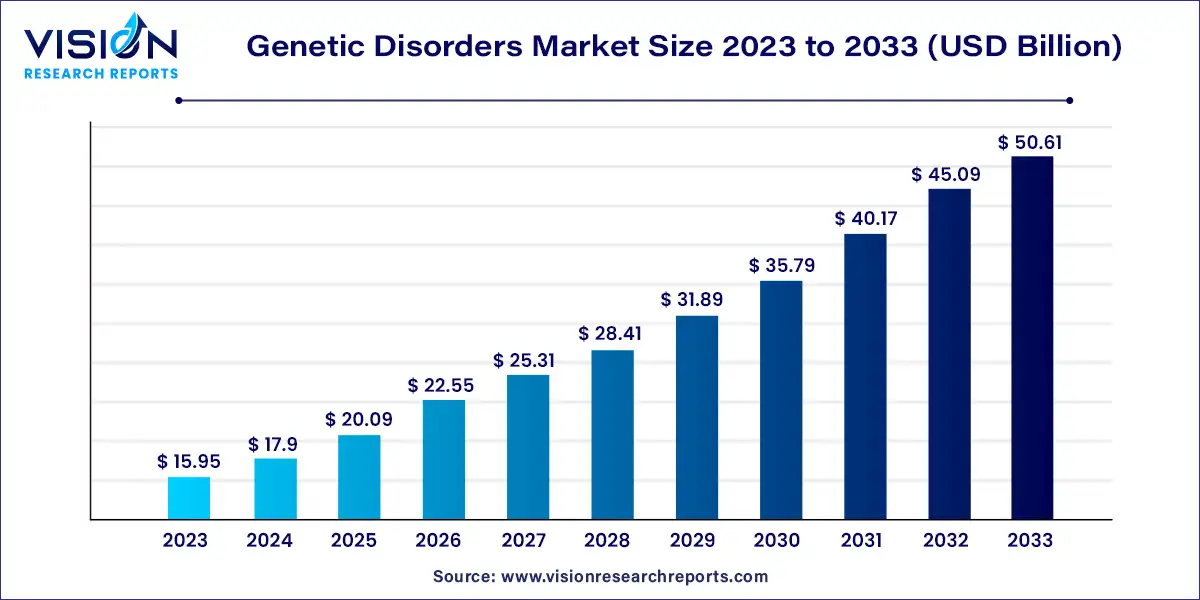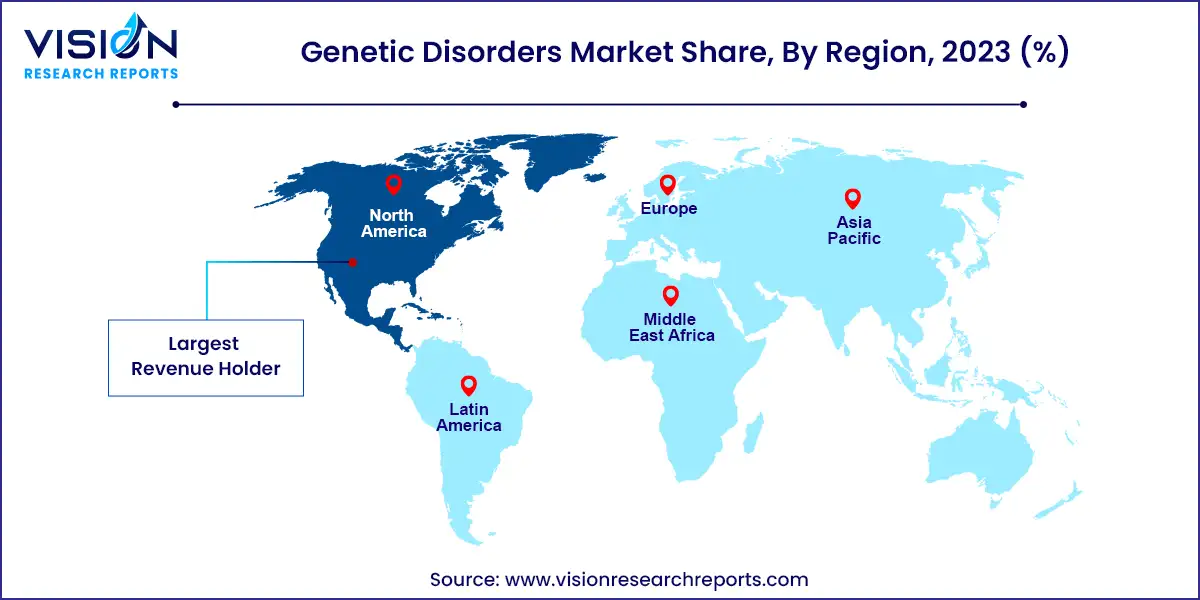The global genetic disorders market size was estimated at around USD 15.95 billion in 2023 and it is projected to hit around USD 50.61 billion by 2033, growing at a CAGR of 12.24% from 2024 to 2033.

The genetic disorders market encompasses a range of products and services aimed at diagnosing, treating, and managing genetic conditions. These disorders result from abnormalities in genes or chromosomes and can be inherited or occur spontaneously. Advances in genetics and biotechnology have significantly impacted this market, leading to innovative treatments and diagnostic tools.
The growth of the genetic disorders market is largely propelled by the technological advancements play a pivotal role, with innovations such as next-generation sequencing (NGS), gene editing technologies like CRISPR, and gene therapy opening new avenues for diagnosis and treatment. These technologies enhance the accuracy of genetic testing and facilitate the development of targeted therapies, driving market expansion. Additionally, increased awareness and education about genetic disorders have led to higher demand for diagnostic services and personalized treatment options. The rising prevalence of genetic disorders, including rare and complex conditions, further fuels market growth by highlighting the need for more effective interventions. Furthermore, supportive government policies and increased healthcare investments in genetic research contribute to the market's growth, fostering an environment conducive to innovation and accessibility.
Cystic Fibrosis (CF) and Duchenne Muscular Dystrophy (DMD) represent significant segments within the global genetic disorders market, each with unique implications for diagnosis and treatment. CF, a genetic disorder caused by mutations in the CFTR gene, leads to severe respiratory and digestive issues. The market for CF is buoyed by advancements in genetic testing and therapeutic interventions. New treatments, such as CFTR modulators, have shown promising results in improving patients' quality of life and extending their lifespan. As awareness and diagnostic capabilities advance, the demand for CF-related treatments and ongoing research continues to grow, reflecting an expanding market segment dedicated to this condition.
Duchenne Muscular Dystrophy (DMD), another critical area within the genetic disorders market, is characterized by progressive muscle degeneration due to mutations in the dystrophin gene. The market for DMD is driven by the need for effective therapies and diagnostic tools. Innovations in gene therapy and exon-skipping techniques offer hope for halting or even reversing the progression of DMD, leading to increased research and investment in this field. The growing understanding of DMD's genetic underpinnings and the development of novel therapeutic approaches contribute to a dynamic market, with a strong focus on improving patient outcomes and extending therapeutic options.
In North America, the market is robust due to the presence of advanced healthcare systems and significant investment in genetic research and technology. The United States and Canada lead in the adoption of cutting-edge genetic testing and therapeutic solutions, supported by a strong network of research institutions and pharmaceutical companies. This region benefits from a high level of awareness and funding, which facilitates the development and accessibility of innovative treatments for genetic disorders.

Europe also represents a substantial segment of the global genetic disorders market, with countries such as Germany, the United Kingdom, and France at the forefront. The European market is characterized by a strong emphasis on research and development, backed by supportive government policies and funding initiatives. The European Union’s commitment to advancing genetic research and healthcare innovation plays a critical role in driving market growth. Additionally, increasing collaborations between research institutions and pharmaceutical companies are fostering advancements in diagnostic and therapeutic options for genetic disorders.
In the Asia Pacific region, the genetic disorders market is experiencing rapid growth, driven by rising healthcare expenditure and growing awareness of genetic conditions. Countries like China, Japan, and India are emerging as significant players, with expanding healthcare infrastructures and increasing investments in genetic research. The rising prevalence of genetic disorders and improvements in diagnostic technologies contribute to the region's market expansion. Additionally, the growing emphasis on personalized medicine and the development of local research and development capabilities are further fueling market growth in this area.
By Indication
By Disease Type
By Region
Chapter 1. Introduction
1.1. Research Objective
1.2. Scope of the Study
1.3. Definition
Chapter 2. Research Methodology
2.1. Research Approach
2.2. Data Sources
2.3. Assumptions & Limitations
Chapter 3. Executive Summary
3.1. Market Snapshot
Chapter 4. Market Variables and Scope
4.1. Introduction
4.2. Market Classification and Scope
4.3. Industry Value Chain Analysis
4.3.1. Raw Material Procurement Analysis
4.3.2. Sales and Distribution Channel Analysis
4.3.3. Downstream Buyer Analysis
Chapter 5. COVID 19 Impact on Genetic Disorders Market
5.1. COVID-19 Landscape: Genetic Disorders Industry Impact
5.2. COVID 19 - Impact Assessment for the Industry
5.3. COVID 19 Impact: Global Major Government Policy
5.4. Market Trends and Opportunities in the COVID-19 Landscape
Chapter 6. Market Dynamics Analysis and Trends
6.1. Market Dynamics
6.1.1. Market Drivers
6.1.2. Market Restraints
6.1.3. Market Opportunities
6.2. Porter’s Five Forces Analysis
6.2.1. Bargaining power of suppliers
6.2.2. Bargaining power of buyers
6.2.3. Threat of substitute
6.2.4. Threat of new entrants
6.2.5. Degree of competition
Chapter 7. Competitive Landscape
7.1.1. Company Market Share/Positioning Analysis
7.1.2. Key Strategies Adopted by Players
7.1.3. Vendor Landscape
7.1.3.1. List of Suppliers
7.1.3.2. List of Buyers
Chapter 8. Global Genetic Disorders Market, By Indication
8.1. Genetic Disorders Market, by Indication, 2024-2033
8.1.1. CF
8.1.1.1. Market Revenue and Forecast (2021-2033)
8.1.2. DMD
8.1.2.1. Market Revenue and Forecast (2021-2033)
8.1.3. LSD
8.1.3.1. Market Revenue and Forecast (2021-2033)
8.1.4. PNH
8.1.4.1. Market Revenue and Forecast (2021-2033)
Chapter 9. Global Genetic Disorders Market, By Disease Type
9.1. Genetic Disorders Market, by Disease Type, 2024-2033
9.1.1. Alzheimer's Disease
9.1.1.1. Market Revenue and Forecast (2021-2033)
9.1.2. Cancer
9.1.2.1. Market Revenue and Forecast (2021-2033)
9.1.3. Cystic fibrosis
9.1.3.1. Market Revenue and Forecast (2021-2033)
9.1.4. Sickle Cell Anaemia
9.1.4.1. Market Revenue and Forecast (2021-2033)
9.1.5. DMD
9.1.5.1. Market Revenue and Forecast (2021-2033)
9.1.6. Thalassemia
9.1.6.1. Market Revenue and Forecast (2021-2033)
9.1.7. Huntington's Disease
9.1.7.1. Market Revenue and Forecast (2021-2033)
9.1.8. Rare Diseases
9.1.8.1. Market Revenue and Forecast (2021-2033)
9.1.9. Others
9.1.9.1. Market Revenue and Forecast (2021-2033)
Chapter 10. Global Genetic Disorders Market, Regional Estimates and Trend Forecast
10.1. North America
10.1.1. Market Revenue and Forecast, by Indication (2021-2033)
10.1.2. Market Revenue and Forecast, by Disease Type (2021-2033)
10.1.3. U.S.
10.1.3.1. Market Revenue and Forecast, by Indication (2021-2033)
10.1.3.2. Market Revenue and Forecast, by Disease Type (2021-2033)
10.1.4. Rest of North America
10.1.4.1. Market Revenue and Forecast, by Indication (2021-2033)
10.1.4.2. Market Revenue and Forecast, by Disease Type (2021-2033)
10.2. Europe
10.2.1. Market Revenue and Forecast, by Indication (2021-2033)
10.2.2. Market Revenue and Forecast, by Disease Type (2021-2033)
10.2.3. UK
10.2.3.1. Market Revenue and Forecast, by Indication (2021-2033)
10.2.3.2. Market Revenue and Forecast, by Disease Type (2021-2033)
10.2.4. Germany
10.2.4.1. Market Revenue and Forecast, by Indication (2021-2033)
10.2.4.2. Market Revenue and Forecast, by Disease Type (2021-2033)
10.2.5. France
10.2.5.1. Market Revenue and Forecast, by Indication (2021-2033)
10.2.5.2. Market Revenue and Forecast, by Disease Type (2021-2033)
10.2.6. Rest of Europe
10.2.6.1. Market Revenue and Forecast, by Indication (2021-2033)
10.2.6.2. Market Revenue and Forecast, by Disease Type (2021-2033)
10.3. APAC
10.3.1. Market Revenue and Forecast, by Indication (2021-2033)
10.3.2. Market Revenue and Forecast, by Disease Type (2021-2033)
10.3.3. India
10.3.3.1. Market Revenue and Forecast, by Indication (2021-2033)
10.3.3.2. Market Revenue and Forecast, by Disease Type (2021-2033)
10.3.4. China
10.3.4.1. Market Revenue and Forecast, by Indication (2021-2033)
10.3.4.2. Market Revenue and Forecast, by Disease Type (2021-2033)
10.3.5. Japan
10.3.5.1. Market Revenue and Forecast, by Indication (2021-2033)
10.3.5.2. Market Revenue and Forecast, by Disease Type (2021-2033)
10.3.6. Rest of APAC
10.3.6.1. Market Revenue and Forecast, by Indication (2021-2033)
10.3.6.2. Market Revenue and Forecast, by Disease Type (2021-2033)
10.4. MEA
10.4.1. Market Revenue and Forecast, by Indication (2021-2033)
10.4.2. Market Revenue and Forecast, by Disease Type (2021-2033)
10.4.3. GCC
10.4.3.1. Market Revenue and Forecast, by Indication (2021-2033)
10.4.3.2. Market Revenue and Forecast, by Disease Type (2021-2033)
10.4.4. North Africa
10.4.4.1. Market Revenue and Forecast, by Indication (2021-2033)
10.4.4.2. Market Revenue and Forecast, by Disease Type (2021-2033)
10.4.5. South Africa
10.4.5.1. Market Revenue and Forecast, by Indication (2021-2033)
10.4.5.2. Market Revenue and Forecast, by Disease Type (2021-2033)
10.4.6. Rest of MEA
10.4.6.1. Market Revenue and Forecast, by Indication (2021-2033)
10.4.6.2. Market Revenue and Forecast, by Disease Type (2021-2033)
10.5. Latin America
10.5.1. Market Revenue and Forecast, by Indication (2021-2033)
10.5.2. Market Revenue and Forecast, by Disease Type (2021-2033)
10.5.3. Brazil
10.5.3.1. Market Revenue and Forecast, by Indication (2021-2033)
10.5.3.2. Market Revenue and Forecast, by Disease Type (2021-2033)
10.5.4. Rest of LATAM
10.5.4.1. Market Revenue and Forecast, by Indication (2021-2033)
10.5.4.2. Market Revenue and Forecast, by Disease Type (2021-2033)
Chapter 11. Company Profiles
11.1. Amicus Therapeutics, Inc. (U.S)
11.1.1. Company Overview
11.1.2. Product Offerings
11.1.3. Financial Performance
11.1.4. Recent Initiatives
11.2. Alexion Pharmaceuticals, Inc. (U.S)
11.2.1. Company Overview
11.2.2. Product Offerings
11.2.3. Financial Performance
11.2.4. Recent Initiatives
11.3. Sanofi (France)
11.3.1. Company Overview
11.3.2. Product Offerings
11.3.3. Financial Performance
11.3.4. Recent Initiatives
11.4. Takeda Pharmaceutical Company Limited (Japan)
11.4.1. Company Overview
11.4.2. Product Offerings
11.4.3. Financial Performance
11.4.4. LTE Scientific
11.5. Vertex Pharmaceuticals Incorporated U.S)
11.5.1. Company Overview
11.5.2. Product Offerings
11.5.3. Financial Performance
11.5.4. Recent Initiatives
11.6. F. Hoffmann-La Roche Ltd (Switzerland)
11.6.1. Company Overview
11.6.2. Product Offerings
11.6.3. Financial Performance
11.6.4. Recent Initiatives
11.7. Abbott (U.S)
11.7.1. Company Overview
11.7.2. Product Offerings
11.7.3. Financial Performance
11.7.4. Recent Initiatives
11.8. Amgen Inc. (U.S)
11.8.1. Company Overview
11.8.2. Product Offerings
11.8.3. Financial Performance
11.8.4. Recent Initiatives
11.9. ELITechGroup (France)
11.9.1. Company Overview
11.9.2. Product Offerings
11.9.3. Financial Performance
11.9.4. Recent Initiatives
11.10. GW Pharmaceuticals plc. (U.K)
11.10.1. Company Overview
11.10.2. Product Offerings
11.10.3. Financial Performance
11.10.4. Recent Initiatives
Chapter 12. Research Methodology
12.1. Primary Research
12.2. Secondary Research
12.3. Assumptions
Chapter 13. Appendix
13.1. About Us
13.2. Glossary of Terms
 Cross-segment Market Size and Analysis for
Mentioned Segments
Cross-segment Market Size and Analysis for
Mentioned Segments
 Additional Company Profiles (Upto 5 With No Cost)
Additional Company Profiles (Upto 5 With No Cost)
 Additional Countries (Apart From Mentioned Countries)
Additional Countries (Apart From Mentioned Countries)
 Country/Region-specific Report
Country/Region-specific Report
 Go To Market Strategy
Go To Market Strategy
 Region Specific Market Dynamics
Region Specific Market Dynamics Region Level Market Share
Region Level Market Share Import Export Analysis
Import Export Analysis Production Analysis
Production Analysis Others
Others